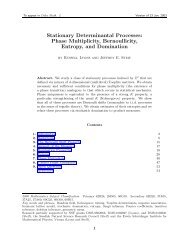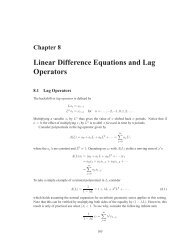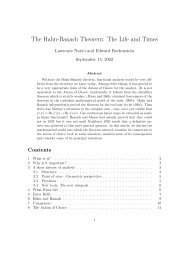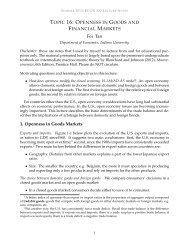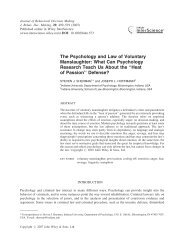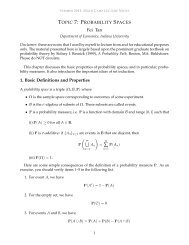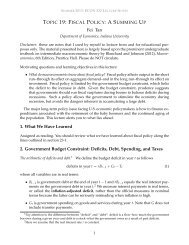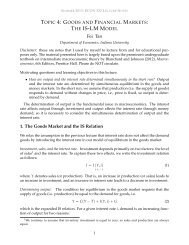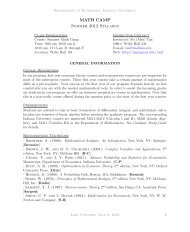Problem Set 3 - Mypage
Problem Set 3 - Mypage
Problem Set 3 - Mypage
Create successful ePaper yourself
Turn your PDF publications into a flip-book with our unique Google optimized e-Paper software.
ECON E724 Joon Y. Park<br />
Economics Department Spring 2013<br />
<strong>Problem</strong> <strong>Set</strong> 3<br />
1. Let W be the standard Brownian motion. Show that<br />
∫ t<br />
∫ t<br />
s dWs = tWt −<br />
0<br />
0<br />
Ws ds.<br />
Generalize this and derive the integration by parts formula<br />
∫ t<br />
∫ t<br />
hs dWs = htWt −<br />
for h that is of bounded variation on [0, t] for any t > 0.<br />
0<br />
0<br />
0<br />
Ws dhs<br />
2. Let W be the standard Brownian motion, and suppose h : [0, ∞) ↦→ R is continuous.<br />
Show that ∫ t<br />
( ∫ t<br />
hs dWs ∼ N 0, h 2 )<br />
s ds<br />
Generalize this and obtain the joint distribution of<br />
(∫ t ∫ t<br />
0<br />
hs dWs,<br />
0<br />
0<br />
ks dWs<br />
where k : [0, ∞) ↦→ R is another continuous function. Use this result to find the joint<br />
distribution of ( ∫ t )<br />
Wt, s dWs<br />
Note that Wt = ∫ t<br />
0 dWs.<br />
3. Let Bt = (Bit) be a vector Brownian motion with variance Σ = (σij). Show that<br />
0<br />
[Bi, Bj]t = σijt<br />
for all i and j. In particular, [Bi, Bj]t = 0 for all t ≥ 0, if σij = 0.<br />
4. Prove directly from the definition of Ito integrals that<br />
∫ t<br />
∫ t<br />
s dMt = tMt −<br />
0<br />
0<br />
)<br />
Ms ds,<br />
where M is a continuous martingale. Can this formula be generalized to<br />
∫ t<br />
∫ t<br />
f(s) dMt = f(t)Mt − Ms df(s)<br />
0<br />
for any function f that is of bounded variation over any compact interval?<br />
0
2<br />
5. Check whether the following processes X are martingales with respect to the filtration<br />
(Ft) generated by the standard Brownian motion W (for (a) - (c)), or the two independent<br />
standard Brownian motions W and V (for (d)).<br />
(a) Xt = Wt + 4t<br />
(b) Xt = W 3 t − 3tWt<br />
(c) Xt = t2Wt − 2 ∫ t<br />
0 sWs ds<br />
(d) Xt = WtVt<br />
6. Let B be the m-dimensional standard vector Brownian motion, i.e., B is defined by<br />
B = (B1, . . . , Bm) ′ , where Bi’s are independent standard Brownian motions. Use Ito’s<br />
formula to write the following n-dimensional stochastic process X on the standard form<br />
for suitable choices of u ∈ R n and v ∈ R n×m :<br />
dXt = u(t, ω) dt + v(t, ω) dBt<br />
(a) Xt = B 2 t , where B is 1-dimensional<br />
(b) Xt = 2 + t + e Bt , where B is 1-dimensional<br />
(c) Xt = (t, B 2 1t + B2 2t )′ , where B = (B1, B2) ′ is 2-dimensional<br />
(d) Xt = (B1t + B2t + B3t, B 2 2t − B1tB3t) ′ , where B = (B1, B2, B3) ′ is 3-dimensional<br />
7. Let W be the standard Brownian motion. Verify that the given processes solve the given<br />
corresponding stochastic differential equations.<br />
(a) Xt = e Wt solves<br />
for t > 0.<br />
(b) Xt = Wt/(1 + t) with W0 = 0 solves<br />
for t > 0 with X0 = 0<br />
dXt = 1<br />
2 Xt dt + Xt dWt<br />
dXt = − 1<br />
1 + t Xt dt + 1<br />
1 + t dWt<br />
(c) Xt = sin Wt with W0 ∈ (−π/2, π/2) solves<br />
for t < T = inf{s|Ws ∈ [−π/2, π/2]}<br />
dXt = − 1<br />
2 Xt dt +<br />
√<br />
1 − X 2 t dWt<br />
(d) Xt = (X1t, X2t) ′ with X1t = t and X2t = etWt solves<br />
( ) (<br />
dX1t 1<br />
for t > 0<br />
dX2t<br />
=<br />
X2t<br />
8. Consider the Ornstein-Uhlenbeck diffusion<br />
)<br />
dt +<br />
( 0<br />
e X1t<br />
dXt = −Xt dt + dWt,<br />
)<br />
dWt
3<br />
and compare the two methods in (a) and (b) below to obtain its quadratic variation. Which<br />
one is wrong and why?<br />
(a) We may derive directly from the diffusion equation<br />
that<br />
∫ t<br />
Xt = X0 − Xs ds + Wt<br />
0<br />
[X]t = [W ]t = t,<br />
since ∫ t<br />
0 Xs ds is of bounded variation.<br />
(b) We should first solve the diffusion equation to obtain<br />
from which we may deduce<br />
Xt = e −t ∫ t<br />
X0 + e −(t−s) dWs,<br />
∫ t<br />
[X]t =<br />
using the formula we learned from the class.<br />
0<br />
0<br />
e 2(t−s) ds = 1 ( −2t<br />
1 − e<br />
2<br />
)



